8.1-8.5: photosynthesis and light reactions
1/85
There's no tags or description
Looks like no tags are added yet.
Name | Mastery | Learn | Test | Matching | Spaced |
|---|
No study sessions yet.
86 Terms
What is the ultimate source of energy for almost all living cells on Earth?
the sun
In a leaf, the thick layer of cells that are rich in chloroplasts is called the ____
mesophyll
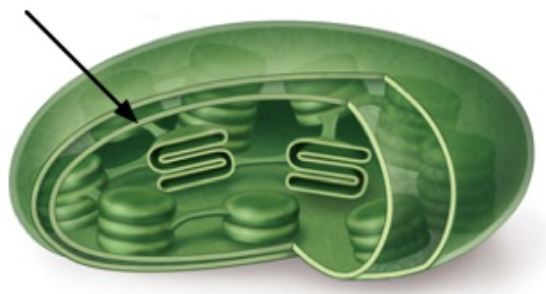
what part of the chloroplast is indicated by the arrow?
inner membrane
Which of the following is made during the light-dependent reactions of photosynthesis?
NADPH
Carbon monoxide
Carbon dioxide
Water
NADPH
The internal membrane of the chloroplast is also known as the Blank______.
lamellar membrane
stromal membrane
thylakoid membrane
primary membrane
thylakoid membrane
The energy used by most living cells comes ultimately from the ________ and is captured through the process of _______.
sun; photosynthesis
Which of the following describes van Helmont's experiment?
He studied the photosynthesis of purple sulfur bacteria.
He measured the effect of different light intensities, CO2 concentrations and temperatures on the rate of photosynthesis.
He grew a willow in a pot keeping an exact record of the weight of the soil and the tree over several years.
He grew a willow in a pot keeping an exact record of the weight of the soil and the tree over several years.
In a green plant, the majority of photosynthesis takes place in Blank______.
the flowers
the leaves
the fruit
the roots
the stem/trunk
the leaves
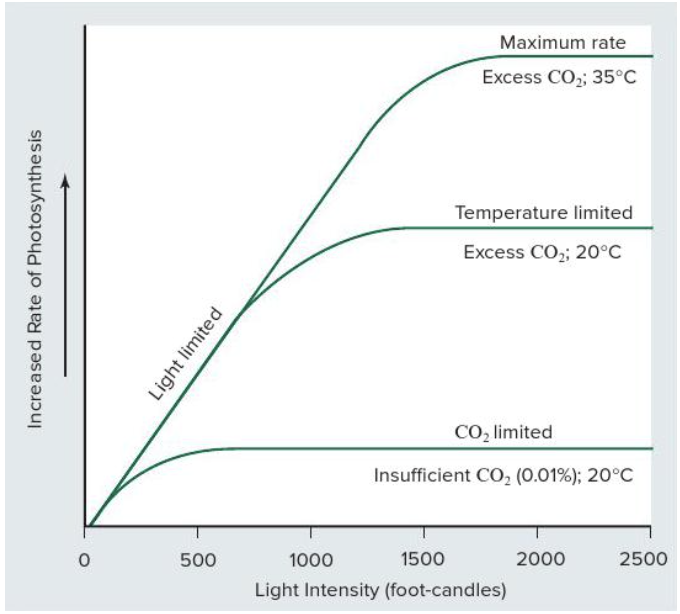
according to the diagram, which of the following accelerate photosynthesis when light intensity is high?
Decrease in temperature
Increase in temperature
Increase in CO2
Decrease in CO2
Increase in temperature
Increase in CO2
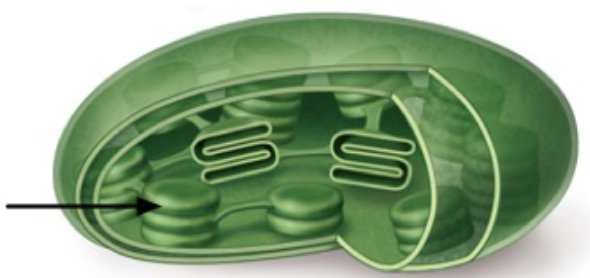
the arrow points to structures in the chloroplast known as ___
grana
The steps of photosynthesis that require light are commonly known as the light-_____ reactions
dependent
The inner (internal) membrane of the chloroplast is also called the ______ membrane.
thylakoid
Jan Baptista ______ _______ performed an experiment for which he grew a willow tree in a pot for several years, during which time he kept an exact record of changes in the weight of the soil.
van Helmont
In van Niel's generalized equation of photosynthesis, which of the following is the donor of electrons?
2A
CO2
H2A
O2
H2A
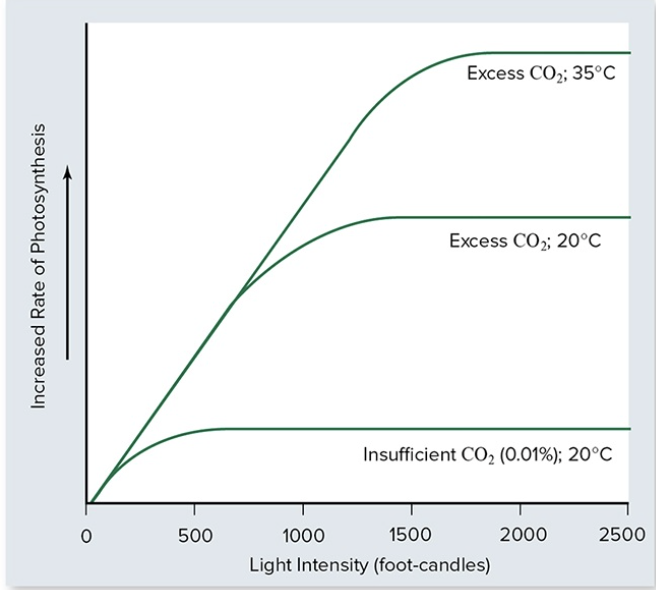
The following diagram shows the change in the rate of photosynthesis as a function of the intensity of light under varying conditions. Which of the following statements can be concluded based on the graph?
The rate of photosynthesis remains constant at all light intensities.
The concentration of CO2 does not play a role in determining the rate of photosynthesis.
The rate of photosynthesis is limited by light at low light intensities.
The rate of photosynthesis is limited by temperature at high light intensities.
The rate of photosynthesis is limited by the concentration of CO2 at high light intensities.
The rate of photosynthesis is limited by light at low light intensities.
The rate of photosynthesis is limited by temperature at high light intensities.
The rate of photosynthesis is limited by the concentration of CO2 at high light intensities.
If chloroplasts are isolated from a plant cell and exposed to light they release _____
oxygen
Which of the following is made during the light-dependent reactions of photosynthesis?
Carbon dioxide
Water
NADPH
Carbon monoxide
NADPH
A leaf that appears to be green to the human eye contains pigment molecules that are ______
reflecting green light
Light has properties of both ______ and _____
a particle and a wave
According to the generalized equation for photosynthesis proposed by van Niel, CO2 + 2H2A + light energy yields which of the following?
2CH2O + ATP
CH2O + H2O
2 CH2O + O2
CH2O + H2O + 2A
CH2O + H2O + 2A
If chloroplasts are isolated from a plant and exposed to light in the absence of carbon dioxide, they accumulate _______
ATP
In the visible spectrum, light energy may be absorbed by boosting _____ to higher atomic energy levels, sometimes called energy shells.
electrons
A graph depicting the efficiency of photon absorption by a pigment molecule as a function of photon wavelength is known as the _____ spectrum of the pigment
absorption
Which are the two most important kinds of pigments in chloroplasts?
Chlorophylls and carotenoids
For an electron to absorb light energy, it must absorb a(n) ______ that contains enough energy to overcome the energy difference between the orbital the electron is in, and the one to which it will be boosted.
photon
The range and efficiency of photons that a pigment molecule is capable of absorbing constitute its characteristic absorption ________
spectrum
The two most important classes of pigments in chloroplasts are chlorophylls and ________
carotenoids
Which of the following are used by green plants to absorb light energy?
Chlorophyll a
Chloroplast c
Xanthophyll b
Chlorophyll b
Chlorophyll c
Chlorophyll a
Chlorophyll b
If chloroplasts are isolated from a plant and exposed to light in the absence of carbon dioxide, they accumulate ________
ATP
In the visible spectrum, light energy may be absorbed by boosting ______ to higher atomic energy levels, sometimes called energy shells.
electrons
In photosynthesis, _____ molecules preferentially absorb violet-blue and red light.
chlorophyll
A graph depicting the efficiency of photon absorption by a pigment molecule as a function of photon wavelength is known as the ________
absorption spectrum of the pigment
On an absorption spectrum for chlorophyll, which color of light would have a low rate of of absorption?
green
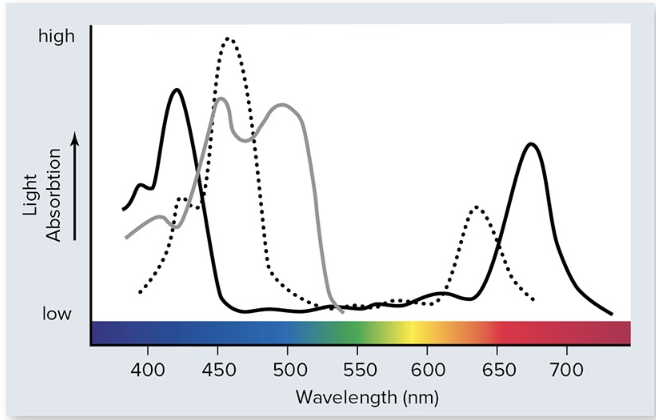
On the following diagram of the absorption spectra of various pigments, the dotted line shows the absorption spectrum of _______
chlorophyll b
Which of the following accurately describes pigments in the chloroplast?
Carotenoids are primary light-absorbing pigments
Chlorophyll a is the main photosynthetic pigment in plants.
Chlorophyll b is the only pigment that can act directly to convert light energy into chemical energy.
Chlorophyll a is the main photosynthetic pigment in plants.
Which of the following wavelengths of light are preferentially absorbed by chlorophyll molecules?
Red
Green
Yellow
Violet-blue
Red
Violet-blue
Which of the following are parts of a chlorophyll molecule?
A hydrocarbon tail
A porphyrin ring
A manganese atom
An anchoring protein
A hydrocarbon tail
A porphyrin ring
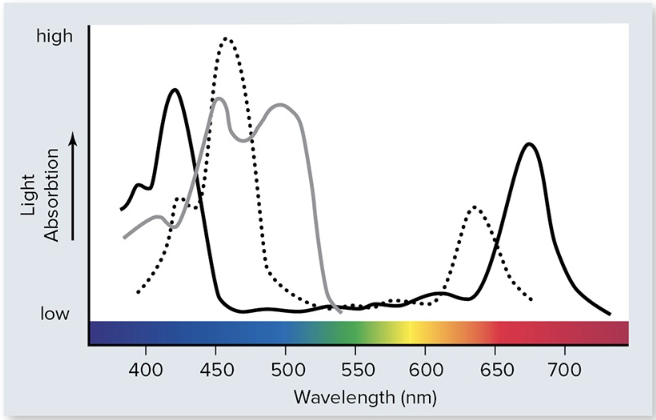
The following diagram represents light absorption as a function of wavelength of various pigments. Which of the three pigments might reflect an orange or red color?
The pigment represented by the gray line
According to the generalized equation for photosynthesis proposed by van Niel, CO2 + 2H2A + light energy yields which of the following?
CH2O + H2O
CH2O + H2O + 2A
2 CH2O + O2
2CH2O + ATP
CH2O + H2O + 2A
Which of the following is an accurate description of carotenoids?
They are made of a porphyrin ring connected to a long hydrophobic chain.
They are made a long carbon chain with multiple double bonds at one end and several hydroxyl groups at the other end.
They are made of carbon rings connected to carbon chains with alternating single and double bonds.
They are made of carbon rings connected to carbon chains with alternating single and double bonds.
Chlorophyll _____ is the main photosynthetic pigment in plants as it converts light energy into chemical energy; chlorophyll _____ acts as an accessory pigment.
a; b
How do carotenoids assist in the photosynthetic process?
By capturing light wavelengths that are not efficiently absorbed by chlorophylls.
A chlorophyll molecule is made of a _____ ring and a ______ tail
porphyrin; hydrophobic
How is the output of photosynthesis related to the amount of light available at different light intensities?
Linear increase at low light intensities and saturation at high light intensities
______ are accessory photosynthetic pigments that consist of carbon rings linked to chains with alternating single and double bonds.
carotenoids
When photosynthesis in the alga Chlorella was studied, scientists determined that the production of one molecule of ______ from water requires several thousand chlorophyll molecules.
oxygen
Similar to other pigments, carotenoids assist photosynthesis by capturing energy from _______, however, they absorb wavelengths that are not efficiently absorbed by ______. In addition, they scavenge ______ radicals.
light/photons; chlorophylls; free
Almost all photosynthetic organisms capture light using ______
photosystems
A photosystem consists of two components, a(n) _____ complex and a(n) ______ center.
antenna; reaction
In a photosystem, the ______ complex captures light energy and passes it to the _____ center where electrons are transferred out of the photosystem.
antenna; reaction
At low light intensities, how is the output of photosynthesis related to the intensity of illumination?
The output of photosynthesis increases linearly with increases in the intensity of illumination.
The role of the _____ -harvesting complex in a photosystem is to directly absorb photons of light.
light
The production of one molecule of O2 during photosynthesis requires how many chlorophyll molecules?
thousands
In chloroplasts, the light-harvesting complex is composed of a web of ______ molecules linked together and held tightly in the thylakoid membrane by a matrix of proteins.
pigment
In all photosynthetic organisms studied to date, except one class of photosynthetic bacteria, light is captured by clusters of chlorophyll and accessory pigment molecules, which together are called _____
photosystems
Once a photon is captured by the light harvesting complex, the pigments in it transfer _______
the energy of excited electrons but not electrons themselves
What are the two components of a photosystem?
A reaction center
An antenna complex
How is the reaction center positioned in the membrane?
It is a transmembrane complex.
In the reaction center of a photosystem, which of the following excited subatomic particles are transferred to an acceptor?
Electrons
Where do the light-dependent reactions of photosynthesis occur in the chloroplast?
In the stroma
In the outer chloroplast membrane
In the thylakoid membrane.
In the thylakoid lumen
In the thylakoid membrane.
The role of the light-harvesting complex is to _____
directly absorb photons of light
Anoxygenic bacteria have how many photosystems?
one
The light-harvesting complex of a photosystem in a green plant contains a large number of _______
pigments
In the light-harvesting complex of the chloroplast, it is excitation ______, not the electrons themselves, that pass from one pigment molecule to the next.
energy
The reaction center in chloroplasts is a transmembrane ______-pigment complex.
protein
the light-______ reactions of photosynthesis occur in the membranes.
dependent
chloroplasts have _____ type(s) of photosystem(s)
two
In chloroplasts, when the two photosystems work in series, electrons ejected from the photosystems do not return to them, which is known as _____
noncyclic photophosphorylation
A Z diagram illustrates how many electron-energizing steps?
two
he electron transport chain directly associated with photosystem II is used to generate ______, while the electron transport chain directly associated with photosystem I is used to generate ______.
ATP; NADPH
The process in which electrons from water move through PSII and PSI and ultimately to NADPH is also known as _______ photophosphorylation
non-cyclic
The ______ diagram describes the energy transitions of electrons as they move through the ______ reactions.
Z; light-dependent
The primary electron acceptor for the excited electron leaving photosystem II is a ______ molecule
plastoquinone
What is the function of the b6-f complex?
To pump protons in the thylakoid space
Which photosystem's main function is to generate high-energy electrons for the synthesis of ATP?
Photosystem II
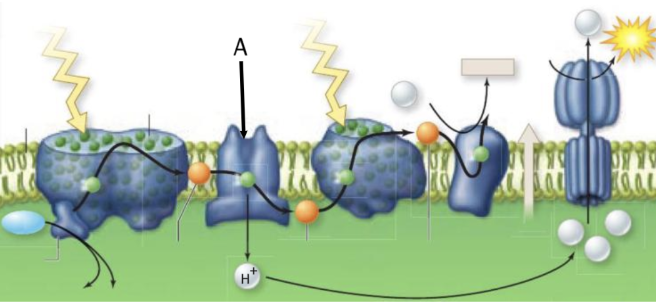
Review the diagram of photosynthesis in the chloroplast. What does the thick arrow labeled with the letter A point to?
b6-f complex
The reaction center of photosystem I consists of a core transmembrane complex made of ___ protein subunits and ___ bound P700 chlorophyll molecules
12-14; 2
Photosystem I passes electrons to
ferredoxin
Reduced plastoquinone is a strong electron donor that passes a pair of electrons to ______
the b6-f complex
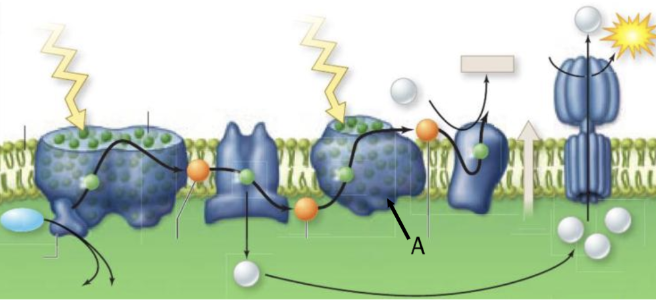
On the following diagram of photosynthesis in the chloroplast, the thick arrow labeled with the letter A points to
photosystem I
On the stromal side of the thylakoid membrane, two molecules of reduced ____ donate two electrons for the synthesis of one molecule of NADPH.
ferredoxin
The iron-sulfur protein _____ accepts electrons from photosystem I.
ferredoxin
The primary electron acceptor for the excited electron leaving photosystem II is a ______ molecule.
plastoquinone
The ATP synthases of chloroplasts and mitochondria are evolutionarily _____
related
Recent studies with the atomic force microscope have shown that PSI and the ATP synthase are not randomly distributed in thylakoid membranes, rather, they seem concentrated primarily in the _______
primarily in the connections between grana (the stroma lamellae)
Which molecule donates electrons for the synthesis of NADPH in chloroplasts?
Reduced ferredoxin